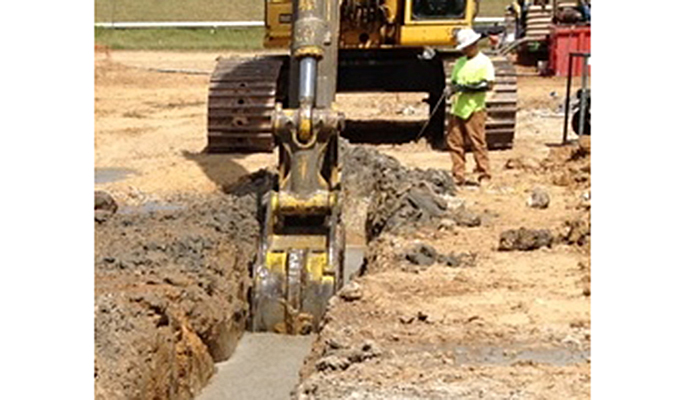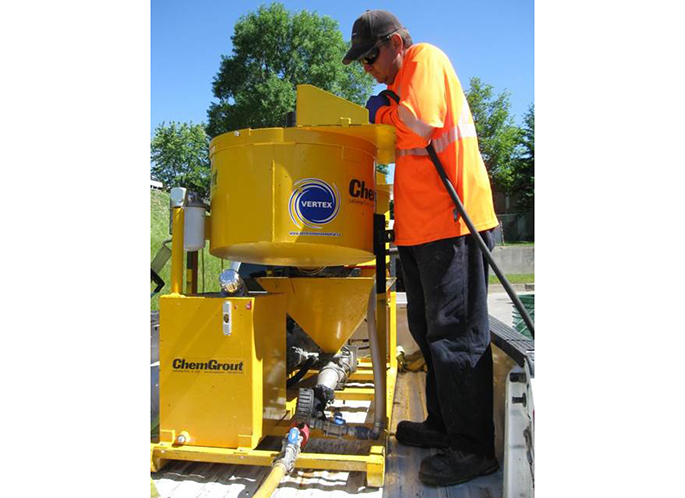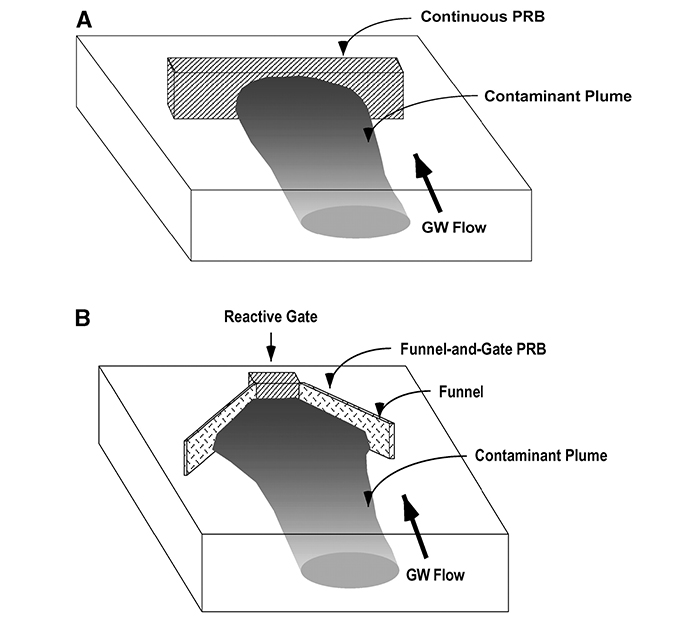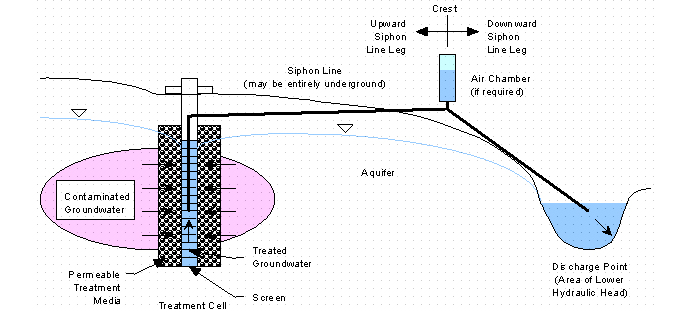PRB Design and Installation
(or Everything You Always Wanted to Know About PRBs, But Were Afraid to Ask – Part 2)
Last month, in honour of innovative Canadian-based research into Permeable Reactive Barriers (PRBs), we presented a brief history and discussion of traditional PRB technologies. Part 1 of the article can be found here.
This article (Part 2) delves deeper into PRBs with a focus on installation, design and discussion on PRBs for non-traditional uses – such as petroleum hydrocarbon (PHC) remediation.
As discussed last month, a PRB is a permeable zone installed below ground. It is designed to have a higher permeability than the aquifer, and takes advantage of the natural flow of groundwater. The contaminant plume is designed to easily flow through and be treated within the PRB without mechanical assistance (i.e. pumps).
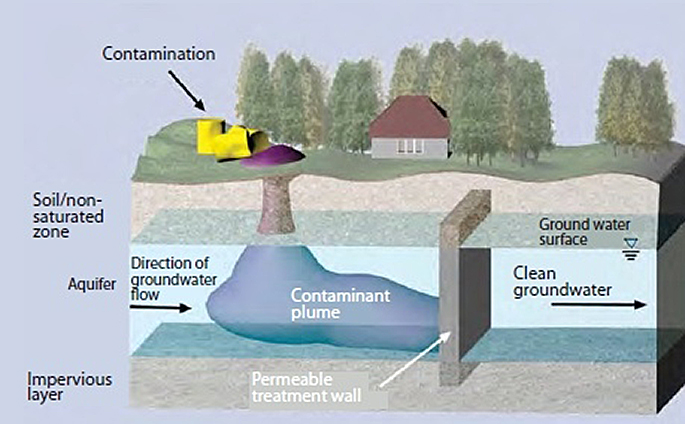
PRB Installation Techniques
There are a variety of PRB installation techniques that have been successfully used. For shallow installations the simplest installation technique involves opening a trench with traditional excavation equipment and placing reactive media and sand mixtures directly into the open trench. These photos were provided in Part 1 of the article, and demonstrate this technique:
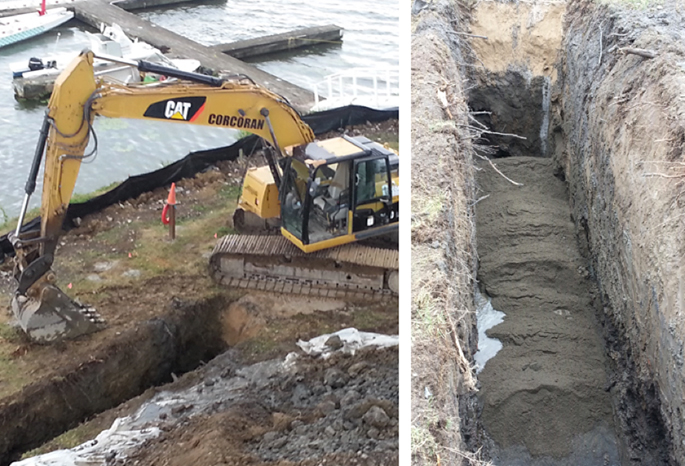
When deeper placement is required (>6 to 9 m) and trench side wall collapse is a risk, trench boxes can be used for stability. Depending on budget, a single pass trencher can also be utilized to construct PRBs.
In permeable aquifers, groundwater control during trenching must also be considered. A common approach to prevent trench side wall collapse and to address inflowing contaminated groundwater is through the use of biopolymer slurries. During excavation, biopolymer slurry is added to maintain the aquifer water level (thus preventing any difference in hydrostatic pressure), and when the target excavation depth is reached, reactive media is injected at the bottom of the trench thereby displacing the biopolymer slurry.
Some work sites can be more challenging for PRB installation, these locations include sites with deep plumes (>9 m), aquifers with heaving sands, or sites where the location of above ground buildings or property lines prevent the mobilization of heavy excavating equipment. In these situations, an approach commonly used by Vertex is PRB installation by high pressure ZVI slurry injection using small diameter injection rods and direct push drill rigs.
Preparation of an ZVI injection slurry:
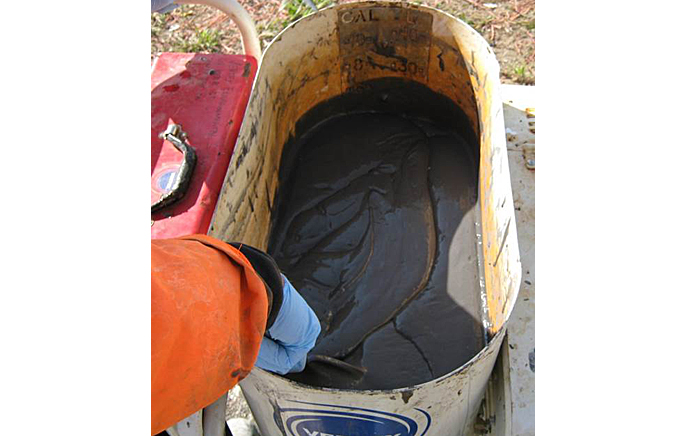
ZVI slurry injections can also be completed using fracture emplacement technology.
Other PRB emplacement technologies include soil mixing equipment using mixing tools connected to excavator arms and direct placement through large diameter augers. All in all, there are many techniques available to successfully install a PRB.
Hybrid PRB Models: For Those Difficult Sites
The first generation of PRBs were constructed using a single reactive material (i.e. zero valent iron or ZVI). Later, PRBs were constructed in series to provide multiple treatment stages. This allowed for longer PRB residence times and the introduction of alternative treatment media. Later still, hybrid formulations were developed, combining, for example, ZVI and organic substrates. Below is an example of a two-stage PRB for the treatment of nitrate-contaminated groundwater:
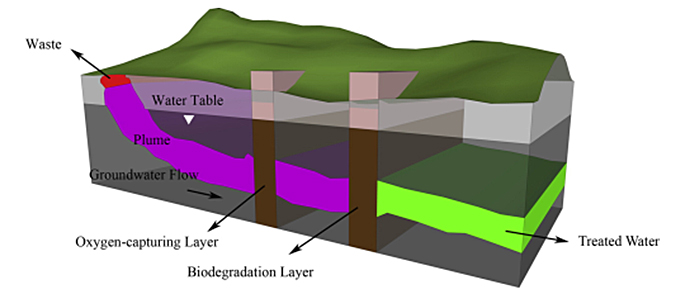
Some products combine micro-scale or nano-scale ZVI with emulsified vegetable oil (called EZVI). Others, such as BOS 100®, impregnate granular activated carbon (GAC) with ZVI in a Trap-and-Treat approach. The GAC is formulated to rapidly remove chlorinated solvents from groundwater by sorption, which is followed by degradation upon contact with the ZVI.
Due to reactive media lifespan or the cost of reactive media, an enhanced PRB installation approach is to incorporate impermeable wing walls to direct the groundwater towards the PRB. This is called a Funnel and Gate system:
One of the more creative uses of the PRB technology is the use of passively siphoning groundwater out of a source area and through a PRB:
Petroleum Hydrocarbon Remediation
For the remediation of PHCs, solid oxygen-release compounds (ORCs) have been placed within PRBs. A more advanced formulation for PHCs is BOS-200®. This material consists of GAC, nutrients, and a facultative bacteria blend. As groundwater moves through the material, the GAC sorbs and holds the contaminants while biological processes degrade the PHCs. Another approach in slow groundwater flow aquifers, is the installation of a coarse stone PRB, where oxidants or oxygen-rich water can be regularly injected. Research is still on-going for the passive long term treatment of PHCs through a PRB.
PRB Design Elements
For a PRB to be successful, the PRB must allow contaminants to easily enter and react with the emplaced reactive media. Prior to design of a PRB, it is important to understand the groundwater flow velocity and direction, and also understand the type, magnitude and location of the contamination you wish to treat. An assessment of geochemistry is also important. This knowledge is used within the PRB design to ultimately calculate the residence time of the contamination within the PRB to ensure the contamination is properly treated prior to exiting the reactive media.
To properly design a PRB, the following should also be considered and understood:
- Good understanding of site characteristics including geology, stratigraphy, geochemistry and groundwater hydraulics
- Maximum expected groundwater plume concentrations and required treatment levels
- Maximum groundwater flow velocity
- Seasonal variability in groundwater elevations
- Depth of plume and suitable confining layer to key the PRB into
Generally, it is imperative to understand the contaminant plume shape and variability in the direction of groundwater flow over time. PRB installation techniques should then be matched with actual site conditions.
ZVI PRBs have been installed and performing in place for more than 20 years in a variety of geochemical environments. It is possible that over this length of time, mineral precipitates can form on the iron surface; this can passivate (coat) reactive sites and possibly begin to clog the PRB. Field observations and modeling have, however, shown that in many cases this loss of porosity and permeability will occur at very low rates.
Solid organic amendments, such as mulch and leafy compost may be preferred in some instances to ZVI based on material cost savings. These organic amendments have been applied in PRBs to treat a range of contaminants that includes chlorinated solvents, acid mine drainage (containing heavy metals), nitrates and sulphates. Physically, mulches are predicted to last 15 to 30 years in the subsurface. However, in practice it appears that such “biowall” PRBs may need to be replenished every 4 to 6 years to sustain the highly reducing conditions required for effective anaerobic degradation. The replenishment strategy can involve the injection of mixtures of soluble and/or insoluble carbon substrate solutions or slurries.
The monitoring program for a PRB should be dynamic. As the PRB ages, the monitoring plan will likely require adjustments to assess variability in both hydraulic and chemical conditions.
Additionally, superior designs include the ability to “surgically” repair or replenish portions of the PRB without the need to replace an entire system.
Closing
From the origin of the concept in the laboratory, through pilot scale validation and – twenty years later – the hundreds of successful full scale installations, PRBs have proven their worth as environmental remediation tools. When properly designed and installed, they are highly effective, passive (low operational cost), and extremely flexible remediation solutions. With the advances in formulations and installation techniques, there is no doubt PRBs will be employed to remediate and protect groundwater globally for many years to come.


